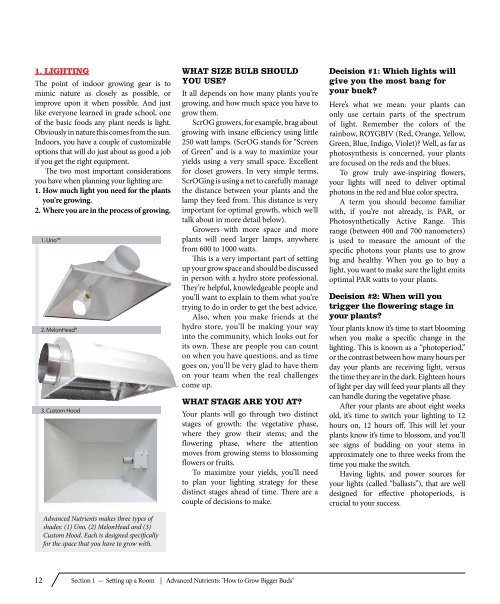You also want an ePaper? Increase the reach of your titles
YUMPU automatically turns print PDFs into web optimized ePapers that Google loves.
1. lighTing<br />
The point of indoor growing gear is to<br />
mimic nature as closely as possible, or<br />
improve upon it when possible. And just<br />
like everyone learned in grade school, one<br />
of the basic foods any plant needs is light.<br />
Obviously in nature this comes from the sun.<br />
Indoors, you have a couple of customizable<br />
options that will do just about as good a job<br />
if you get the right equipment.<br />
The two most important considerations<br />
you have when planning your lighting are:<br />
1. How much light you need for the plants<br />
you're growing.<br />
2. Where you are in the process of growing.<br />
1. Uno<br />
2. MelonHead®<br />
3. Custom Hood<br />
Advanced Nutrients makes three types of<br />
shades: (1) Uno, (2) MelonHead and (3)<br />
Custom Hood. Each is designed specifically<br />
for the space that you have to grow with.<br />
WhaT size bulb should<br />
You use?<br />
It all depends on how many plants you're<br />
growing, and how much space you have to<br />
grow them.<br />
ScrOG growers, for example, brag about<br />
growing with insane efficiency using little<br />
250 watt lamps. (ScrOG stands for “Screen<br />
of Green” and is a way to maximize your<br />
yields using a very small space. Excellent<br />
for closet growers. In very simple terms,<br />
ScrOGing is using a net to carefully manage<br />
the distance between your plants and the<br />
lamp they feed from. This distance is very<br />
important for optimal growth, which we'll<br />
talk about in more detail below).<br />
Growers with more space and more<br />
plants will need larger lamps, anywhere<br />
from 600 to 1000 watts.<br />
This is a very important part of setting<br />
up your grow space and should be discussed<br />
in person with a hydro store professional.<br />
They’re helpful, knowledgeable people and<br />
you’ll want to explain to them what you’re<br />
trying to do in order to get the best advice.<br />
Also, when you make friends at the<br />
hydro store, you’ll be making your way<br />
into the community, which looks out for<br />
its own. These are people you can count<br />
on when you have questions, and as time<br />
goes on, you’ll be very glad to have them<br />
on your team when the real challenges<br />
come up.<br />
WhaT sTage are You aT?<br />
Your plants will go through two distinct<br />
stages of growth: the vegetative phase,<br />
where they grow their stems; and the<br />
flowering phase, where the attention<br />
moves from growing stems to blossoming<br />
flowers or fruits.<br />
To maximize your yields, you’ll need<br />
to plan your lighting strategy for these<br />
distinct stages ahead of time. There are a<br />
couple of decisions to make.<br />
12 Section 1 - Setting up a Room | Advanced Nutrients: "How to Grow <strong>Bigger</strong> <strong>Buds</strong>"<br />
decision #1: Which lights will<br />
give you the most bang for<br />
your buck?<br />
Here’s what we mean: your plants can<br />
only use certain parts of the spectrum<br />
of light. Remember the colors of the<br />
rainbow, ROYGBIV (Red, Orange, Yellow,<br />
Green, Blue, Indigo, Violet)? Well, as far as<br />
photosynthesis is concerned, your plants<br />
are focused on the reds and the blues.<br />
To grow truly awe-inspiring flowers,<br />
your lights will need to deliver optimal<br />
photons in the red and blue color spectra.<br />
A term you should become familiar<br />
with, if you’re not already, is PAR, or<br />
Photosynthetically Active Range. This<br />
range (between 400 and 700 nanometers)<br />
is used to measure the amount of the<br />
specific photons your plants use to grow<br />
big and healthy. When you go to buy a<br />
light, you want to make sure the light emits<br />
optimal PAR watts to your plants.<br />
decision #2: When will you<br />
trigger the flowering stage in<br />
your plants?<br />
Your plants know it’s time to start blooming<br />
when you make a specific change in the<br />
lighting. This is known as a “photoperiod,”<br />
or the contrast between how many hours per<br />
day your plants are receiving light, versus<br />
the time they are in the dark. Eighteen hours<br />
of light per day will feed your plants all they<br />
can handle during the vegetative phase.<br />
After your plants are about eight weeks<br />
old, it’s time to switch your lighting to 12<br />
hours on, 12 hours off. This will let your<br />
plants know it’s time to blossom, and you’ll<br />
see signs of budding on your stems in<br />
approximately one to three weeks from the<br />
time you make the switch.<br />
Having lights, and power sources for<br />
your lights (called “ballasts”), that are well<br />
designed for effective photoperiods, is<br />
crucial to your success.


